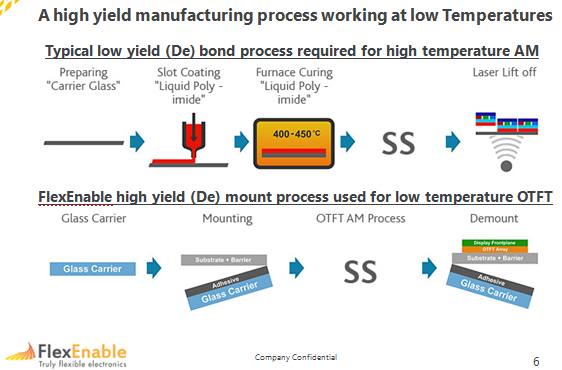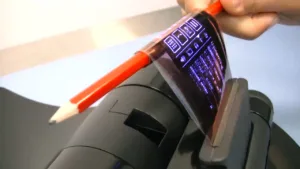This week, I made a visit to FlexEnable, the company that is the ip and technology part of the Plastic Logic company that split between the factory in Dresden (which continues as Plastic Logic GmbH) and the R&D/licensing group in Cambridge. I was surprised to realise that although they are relatively local and we have been reporting on the company since 2000 (almost 150 articles since then!), I had never been to the offices and pilot production line in the Science Park that is the heart of “Silicon Fen”.
I met with Paul Cain, Strategy Director of the company, who has been on the team since the early days in October 2001. We stuck to technical topics, as Chris Chinnock recently gave a great overview of the company’s business approach. (FlexEnable, Merck and Partners Energize Interest in Plastic LCD Technology)
Key to the FlexEnable technology is the ability to process transistors, of better mobility than those of typical amorphous LCDs, onto plastic that can be down to 50µm thick, while not needing high temperature processes. Cain wouldn’t be drawn on precise mobility ratings, but it is said to be “better than amorphous, but below oxide”. That means it’s on the lower end of what is needed for OLED applications.
The transistors themselves are flexible, and as a result, the films can be bent to very small radii (around a matchstick) repeatedly, without any degradation in performance. Cain had a large sheet of film with 1.2 million transistors on it, made on the pilot line, which can make arrays up to 14″ (in weeks to months for quick prototyping and proof of concept). Cain pointed out that at one time, transistor arrays were really defined by just the electrical properties, but the mechanical properties are now becoming just as important.
The transistors are deposited by “many” printing methods as solution-based processing is standard. Again specifics were hard to get, but Cain said “photo litho” of a type was one deposition method and although the talk was, some years ago, of inkjet printing, other techniques are being used.
 FlexEnable’s de-bond process is said to have 100% yieldBecause the techniques are similar to others in the LCD industry, the arrays can be deposited with relatively small changes to standard LCD equipment. The films are attached to glass substrates for processing and FlexEnable has proprietary methods for lifting the film away from the glass, which is left “perfectly clean” and can be reused – it’s just a carrier. The de-mount process is said to have 100% yield.
FlexEnable’s de-bond process is said to have 100% yieldBecause the techniques are similar to others in the LCD industry, the arrays can be deposited with relatively small changes to standard LCD equipment. The films are attached to glass substrates for processing and FlexEnable has proprietary methods for lifting the film away from the glass, which is left “perfectly clean” and can be reused – it’s just a carrier. The de-mount process is said to have 100% yield.
While flexible OLEDs are an obvious target for the technology, the firm has been working on flexible LCDs with Merck. Films for LCD manufacture are hard to find because they have to be colourless, non-birefringent and allow deposition at low temperature. The FlexEnable technology allows even standard, very low cost, TAC film to be used, although PET is more often the choice for the firm’s arrays. Traditional ball spacers are not usable with plastic films as they tend to dig into the film, so we understand that something like a “spacer on transistor” approach was used in the work with Merck.
As well as the partnership with Merck, FlexEnable has been working with Novaled of Germany (which is, of course, now owned by Samsung – Man. Ed.). Flexible OLEDs can be built with the transistor array on one of the barrier films so the display is only as thick as the two 50 /u films.
Outside the display area, FlexEnable sees a lot of opportunities for other “activating surfaces”, where its transistors can be used on a variety of curved and flexible surfaces, for example in automotive applications.
Analyst Comment
It seems to me that there were three requirements for flexible displays to really take off. You need a flexible transistor array, which FlexEnable has, you need a flexible display element, which OLED provides, and you need flexible touch technology, which companies such as 3M, Cambrios and Canatu are providing. Bringing all of these together is going to enable some very exciting products over the next couple of years. Cain told us that he expects to see the firm’s technology in a “real OLED-based product” by around 2017. (BR)

